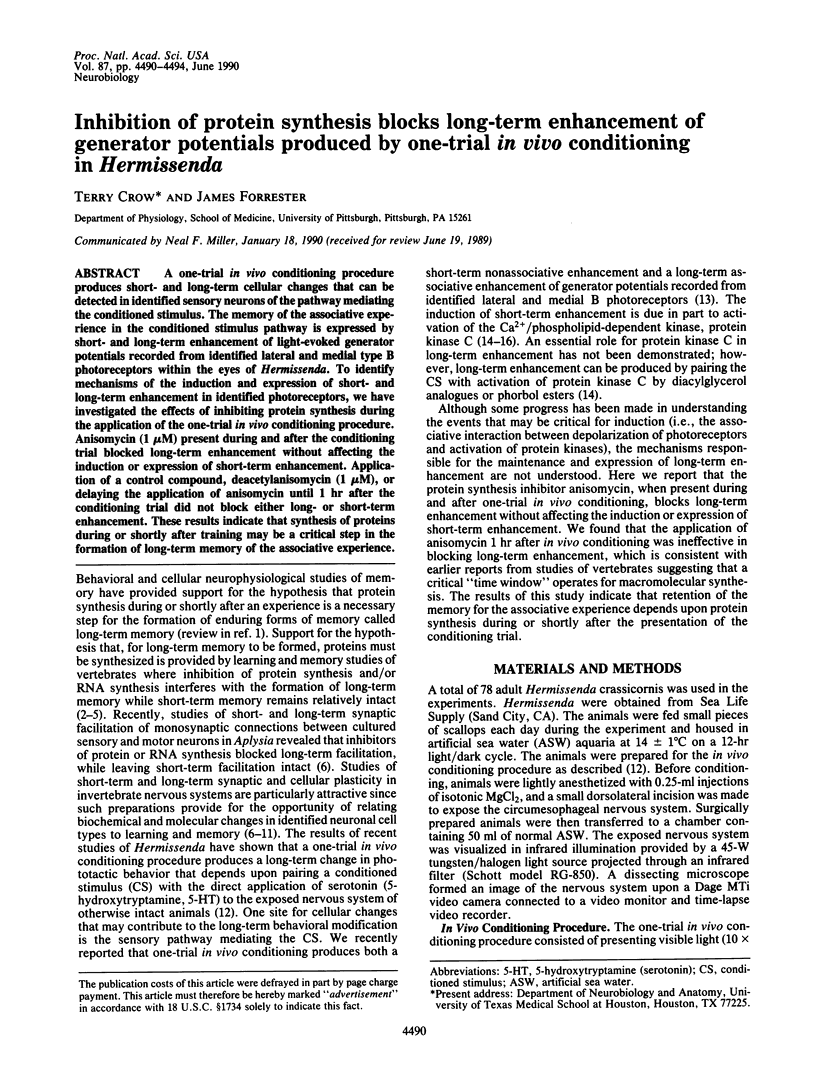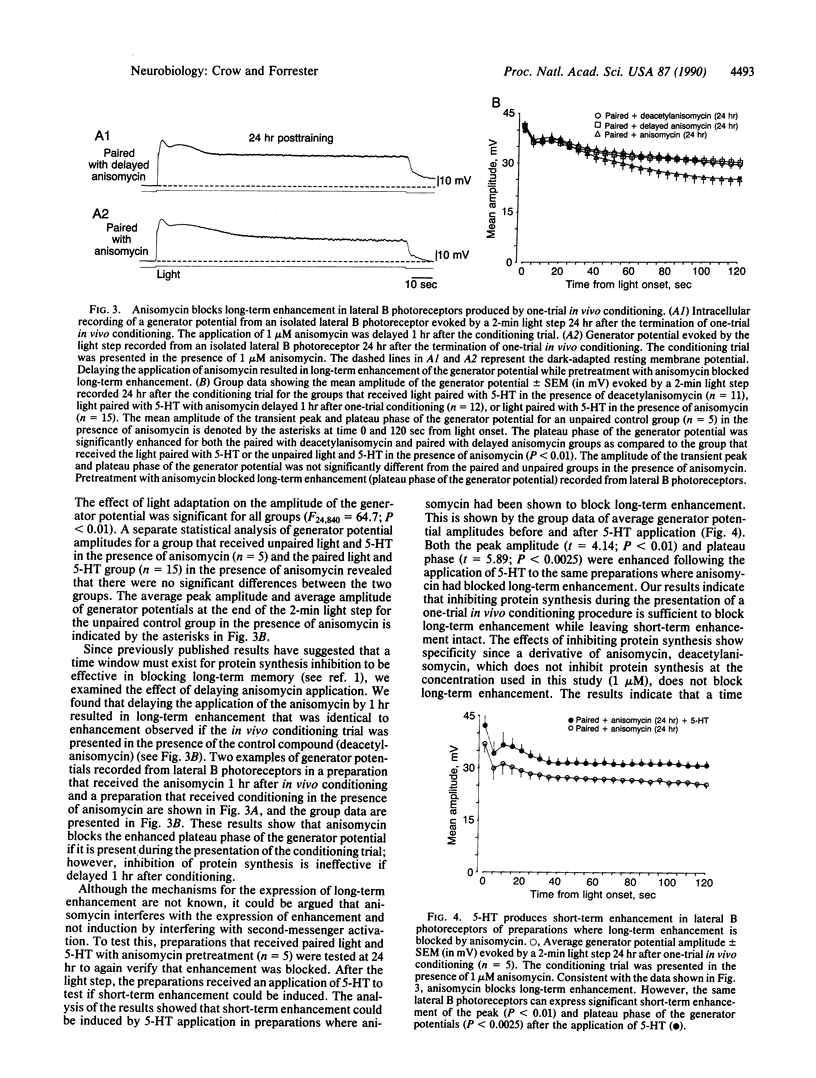Abstract
A one-trial in vivo conditioning procedure produces short- and long-term cellular changes that can be detected in identified sensory neurons of the pathway mediating the conditioned stimulus. The memory of the associative experience in the conditioned stimulus pathway is expressed by short- and long-term enhancement of light-evoked generator potentials recorded from identified lateral and medial type B photoreceptors within the eyes of Hermissenda. To identify mechanisms of the induction and expression of short- and long-term enhancement in identified photoreceptors, we have investigated the effects of inhibiting protein synthesis during the application of the one-trial in vivo conditioning procedure. Anisomycin (1 microM) present during and after the conditioning trial blocked long-term enhancement without affecting the induction or expression of short-term enhancement. Application of a control compound, deacetylanisomycin (1 microM), or delaying the application of anisomycin until 1 hr after the conditioning trial did not block either long- or short-term enhancement. These results indicate that synthesis of proteins during or shortly after training may be a critical step in the formation of long-term memory of the associative experience.
Full text
PDF




Selected References
These references are in PubMed. This may not be the complete list of references from this article.
- Castellucci V. F., Blumenfeld H., Goelet P., Kandel E. R. Inhibitor of protein synthesis blocks long-term behavioral sensitization in the isolated gill-withdrawal reflex of Aplysia. J Neurobiol. 1989 Jan;20(1):1–9. doi: 10.1002/neu.480200102. [DOI] [PubMed] [Google Scholar]
- Castellucci V. F., Kennedy T. E., Kandel E. R., Goelet P. A quantitative analysis of 2-D gels identifies proteins in which labeling is increased following long-term sensitization in Aplysia. Neuron. 1988 Jun;1(4):321–328. doi: 10.1016/0896-6273(88)90080-3. [DOI] [PubMed] [Google Scholar]
- Crow T. Cellular and molecular analysis of associative learning and memory in Hermissenda. Trends Neurosci. 1988 Apr;11(4):136–147. doi: 10.1016/0166-2236(88)90138-5. [DOI] [PubMed] [Google Scholar]
- Crow T. Conditioned modification of phototactic behavior in Hermissenda. I. Analysis of light intensity. J Neurosci. 1985 Jan;5(1):209–214. doi: 10.1523/JNEUROSCI.05-01-00209.1985. [DOI] [PMC free article] [PubMed] [Google Scholar]
- Crow T., Forrester J. Light paired with serotonin mimics the effect of conditioning on phototactic behavior of Hermissenda. Proc Natl Acad Sci U S A. 1986 Oct;83(20):7975–7978. doi: 10.1073/pnas.83.20.7975. [DOI] [PMC free article] [PubMed] [Google Scholar]
- Dale N., Kandel E. R., Schacher S. Serotonin produces long-term changes in the excitability of Aplysia sensory neurons in culture that depend on new protein synthesis. J Neurosci. 1987 Jul;7(7):2232–2238. doi: 10.1523/JNEUROSCI.07-07-02232.1987. [DOI] [PMC free article] [PubMed] [Google Scholar]
- Davis H. P., Rosenzweig M. R., Bennett E. L., Squire L. R. Inhibition of cerebral protein synthesis: dissociation of nonspecific effects and amnesic effects. Behav Neural Biol. 1980 Jan;28(1):99–104. doi: 10.1016/s0163-1047(80)93202-1. [DOI] [PubMed] [Google Scholar]
- Davis H. P., Squire L. R. Protein synthesis and memory: a review. Psychol Bull. 1984 Nov;96(3):518–559. [PubMed] [Google Scholar]
- FLEXNER J. B., FLEXNER L. B., STELLAR E. Memory in mice as affected by intracerebral puromycin. Science. 1963 Jul 5;141(3575):57–59. doi: 10.1126/science.141.3575.57. [DOI] [PubMed] [Google Scholar]
- Grollman A. P. Inhibitors of protein biosynthesis. II. Mode of action of anisomycin. J Biol Chem. 1967 Jul 10;242(13):3226–3233. [PubMed] [Google Scholar]
- Jacklet J. W. Protein synthesis requirement of the Aplysia circadian clock. Tested by active and inactive derivatives of the inhibitor anisomycin. J Exp Biol. 1980 Apr;85:33–42. doi: 10.1242/jeb.85.1.33. [DOI] [PubMed] [Google Scholar]
- Land P. W., Crow T. Serotonin immunoreactivity in the circumesophageal nervous system of Hermissenda crassicornis. Neurosci Lett. 1985 Dec 4;62(2):199–205. doi: 10.1016/0304-3940(85)90355-6. [DOI] [PubMed] [Google Scholar]
- Montarolo P. G., Goelet P., Castellucci V. F., Morgan J., Kandel E. R., Schacher S. A critical period for macromolecular synthesis in long-term heterosynaptic facilitation in Aplysia. Science. 1986 Dec 5;234(4781):1249–1254. doi: 10.1126/science.3775383. [DOI] [PubMed] [Google Scholar]
- Ocorr K. A., Walters E. T., Byrne J. H. Associative conditioning analog selectively increases cAMP levels of tail sensory neurons in Aplysia. Proc Natl Acad Sci U S A. 1985 Apr;82(8):2548–2552. doi: 10.1073/pnas.82.8.2548. [DOI] [PMC free article] [PubMed] [Google Scholar]
- Otani S., Marshall C. J., Tate W. P., Goddard G. V., Abraham W. C. Maintenance of long-term potentiation in rat dentate gyrus requires protein synthesis but not messenger RNA synthesis immediately post-tetanization. Neuroscience. 1989;28(3):519–526. doi: 10.1016/0306-4522(89)90001-8. [DOI] [PubMed] [Google Scholar]
- Schacher S., Castellucci V. F., Kandel E. R. cAMP evokes long-term facilitation in Aplysia sensory neurons that requires new protein synthesis. Science. 1988 Jun 17;240(4859):1667–1669. doi: 10.1126/science.2454509. [DOI] [PubMed] [Google Scholar]
- Scholz K. P., Byrne J. H. Intracellular injection of cAMP induces a long-term reduction of neuronal K+ currents. Science. 1988 Jun 17;240(4859):1664–1666. doi: 10.1126/science.2837826. [DOI] [PubMed] [Google Scholar]
- Sweatt J. D., Kandel E. R. Persistent and transcriptionally-dependent increase in protein phosphorylation in long-term facilitation of Aplysia sensory neurons. Nature. 1989 May 4;339(6219):51–54. doi: 10.1038/339051a0. [DOI] [PubMed] [Google Scholar]


